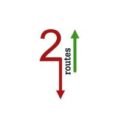Forex and CFDs are both used for speculation on financial markets, but they have some key differences:
Underlying Asset:
- Forex: You directly trade currency pairs, like EUR/USD or GBP/JPY. You are essentially buying one currency while selling another, hoping the exchange rate moves in your favor.
- CFDs: CFDs are contracts for difference. You speculate on the price movement of an underlying asset without actually owning it. This can include currencies (like forex), stocks, commodities, indices, and even cryptocurrencies.
Ownership:
- Forex: In forex trading, you own the currencies in the pair you trade. If you buy EUR/USD, you own the Euros and have sold US Dollars.
- CFDs: With CFDs, you don’t own the underlying asset. You only have a contract that reflects the price difference.
Leverage:
- Forex: Forex brokers typically offer high leverage for currency pairs. This allows you to control a larger position size than your deposit, potentially amplifying profits (and losses).
- CFDs: Leverage can also be applied to CFD trading, but regulations in some regions might restrict leverage amounts depending on the underlying asset.
Settlement:
- Forex: Forex trades are typically settled by delivery vs. payment (DVP) where the currencies are exchanged physically or electronically.
- CFDs: CFDs are cash-settled contracts. You receive or pay the difference in value between the opening and closing of your CFD trade.
Costs:
- Forex: Forex brokers mainly make money through spreads (the difference between the buy and sell price of a currency pair).
- CFDs: CFDs can involve spreads, commissions per trade, and overnight financing fees if you hold positions overnight.
Overall:
- Forex: Forex trading is ideal if you specifically want to speculate on currency exchange rates. It offers high leverage and direct ownership of the underlying currencies.
- CFDs: CFDs provide more flexibility as you can speculate on a wider range of assets beyond just currencies. However, CFDs can be more complex due to additional costs and the lack of ownership of the underlying asset.
Here’s a table summarizing the key differences:
| Feature | Forex | CFDs |
|---|---|---|
| Underlying Asset | Currency pairs (EUR/USD, etc.) | Currencies, Stocks, Commodities, Indices, Crypto |
| Ownership | Yes (of the currencies in the pair) | No (contract on the price movement) |
| Leverage | Typically High | Varies by asset and regulation |
| Settlement | Delivery vs. Payment (DVP) | Cash-settled |
| Costs | Spreads | Spreads, Commissions, Overnight Financing |
Choosing between forex and CFDs depends on your trading goals and preferences. If you specifically want to trade currencies and leverage the forex market dynamics, forex might be a good option. If you seek more flexibility in terms of tradable assets, CFDs could be a better fit, but be aware of the added complexity and potential costs.
